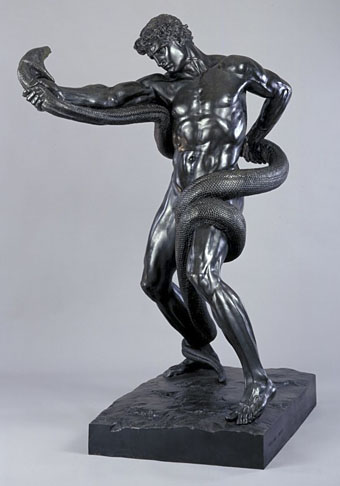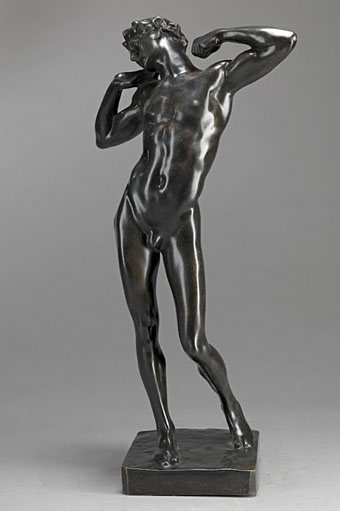An Athlete Wrestling with a Python (1877).
The python wrestler by Frederic Leighton (1830–1896) has appeared here before, and it’s one sculpture that always catches my eye for having appeared in my adaptation of The Call of Cthulhu in 1988. It’s now one of the Leighton works available for close viewing at the Google Art Project although only from a single angle, something that seems a flaw in web presentation of three-dimensional art.
The Sluggard (c. 1895).
In the same collection is a copy of Leighton’s The Sluggard from the Yale Center for British Art. What’s notable about this piece is that it’s generally offered as Exhibit A for the homo-prosecution during discussion of the artist’s sexuality. The Sluggard to which most people refer is the life-size bronze which is a lot more robust and muscular than this lithe and twinky specimen. According to a note at the V&A Yale’s copy is one of many cast from the clay model for the life-size version. What was excused at the time as a late Victorian exercise in contrapossto looks even more camp—in the Philip Core definition—than the finished piece which makes me wonder whether Leighton beefed up the original to disguise something. Core defined camp as “the lie that tells the truth”; camp art always pretends to be one thing whilst simultaneously telegraphing a very different message about its creator. Leighton’s sexuality is a source of continual speculation which means it’s unlikely now to be resolved in any direction, and the artist himself would loathe our prurience, but it’s only by reappraising works in this way that we’re able to show that gay people didn’t magically erupt via some process of spontaneous generation in 1967. If Leighton had any dalliances whilst holidaying in the gay resort of Capri then he was perfectly circumspect. Back at home, as a President of the Royal Academy he had a rather pompous and remote reputation, being memorably described by Violet Paget as “something between an Olympian Jove and a head waiter.” For more camp, see The Narcissus Hall in the artist’s incredibly lavish home, Leighton House in London, where 1st Baron Leighton, PRA, lived splendidly alone.
Previously on { feuilleton }
• Angelo Colarossi and son
• Men with snakes



By a strange coincidence just yesterday at lunchtime from work I walked over to the Sydney Art Gallery and one of the pieces I saw there was:
http://www.flickr.com/photos/sftrajan/3722463780/
http://www.flickr.com/photos/sydneywatertiger/2237921059/in/set-72157619686055246
http://www.flickr.com/photos/sydneywatertiger/417100565/in/photostream
Which view do you prefer?
PS They seem to have quite a few of his works at the gallery
http://www.artgallery.nsw.gov.au/collection/search/?artist_id=leighton-lord-frederic
My favourite is: http://en.wikipedia.org/wiki/File:Iphigenia.jpg
Oh, that is a surprise. It’s good to see one showing the right-hand side (of the figure, that is), you seldom see that view.
And by another coincidence, tomorrow’s post will concern a sketch for Cymon and Iphigenia.
Do you prefer the sculputure in black or in white?
I presume the black one is the original version.
How big is the original?
The one here in Sydney is slightly large than life size (assuming I’m an average sized male. :-)
I prefer the bronzes where these are concerned, the highlights help mould the shape.
And the python wrestler in the Tate is a life-size figure.
Man, if The Sluggard were any twinkier, it would have a contract with Helix Studios.
PS They seem to have quite a few of his works at the gallery
The Colonies were awash with gold-rush money at the time of the English Olympians, and the local art galleries had agents in London to cherry-pick from each Academy exhibition. If you want to see the complete Waterhouse or Leighton oeuvre, you need to travel down here to the antipodes.